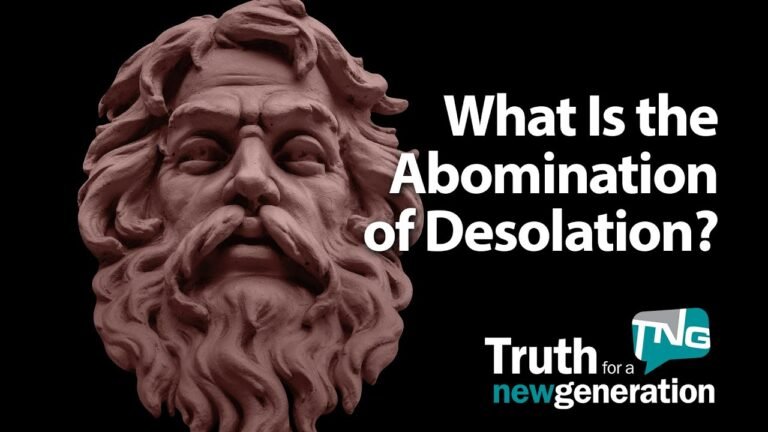Understanding the Abomination of Desolation
The phrase abomination of desolation has intrigued scholars and believers alike, often evoking vivid imagery and deep theological implications. Rooted in biblical prophecy, particularly in the books of Daniel and Revelation, this term refers to a significant event or figure that signifies profound desecration and impending judgment. As we explore its meaning and relevance, we uncover layers of historical context, spiritual significance, and its enduring impact on contemporary faith discussions. Join us as we delve into what the abomination of desolation truly represents and why it continues to resonate across generations.
What does abomination of desolation signify?
The abomination of desolation refers to a sacrilegious act or object that desecrates a sacred space, often linked to prophetic biblical events.
What is the meaning of the abomination of desolation in the Book of Mark?
The abomination of desolation refers to a horrific event that renders a sacred space forsaken and desecrated, specifically within the context of the temple. This concept is rooted in biblical prophecy, with references found in the Gospel of Matthew, which cites the Book of Daniel as its source. Daniel foretells this ominous occurrence in several passages, highlighting its significance as a pivotal moment in eschatological events. The term evokes a sense of urgency and warning, underscoring the gravity of turning away from the divine.
What is the meaning of abomination of desolation in Hebrew?
The term “abomination of desolation” in Hebrew derives from the root word “shaqats,” which signifies being filthy, loathsome, or abominable. This phrase predominantly references idolatrous worship practices that are considered highly offensive to moral and ethical standards. Such practices evoke a strong sense of revulsion, highlighting a profound disconnection from purity and righteousness, and serve as a stark warning against the desecration of sacred spaces through immoral acts.
What is the abomination that brings desolation in the Bible?
The term often referred to as “the abomination that causes desolation” in the Bible has its roots in a historical event that took place around 200 years prior to its mention in scripture. This grotesque act was committed by Antiochus Epiphanes, who desecrated the temple by sacrificing a pig to Zeus, an offense that symbolized a profound betrayal of the sacred. This moment not only marked a significant moment of desolation in the hearts of the faithful but also underscored the tension between religious reverence and oppressive power, leaving a lasting impact on the collective memory of the Jewish people.
Unraveling the Mystery Behind the Prophecy
For centuries, the prophecy has captivated the imagination of scholars, mystics, and seekers alike, weaving a tapestry of hope and intrigue. Rooted in ancient texts and whispered legends, its enigmatic verses hint at a transformative event that could alter the course of history. As researchers delve deeper into the symbolism and context surrounding the prophecy, they uncover connections to celestial phenomena, historical milestones, and the human spirit’s resilience. Each revelation brings us closer to understanding its true significance, inviting us to reflect on our own roles in shaping the future and igniting a collective quest for meaning in a world steeped in uncertainty.
A Deep Dive into Ancient Scriptures
Ancient scriptures serve as a profound window into the beliefs, values, and histories of early civilizations, offering invaluable insights into the human experience. From the poetic verses of the Rigveda to the philosophical musings of the Tao Te Ching, these texts not only document spiritual practices but also reflect the social and cultural dynamics of their time. Each scripture, steeped in its unique context, invites readers to explore the intricate tapestry of humanity’s quest for meaning, connection, and understanding. As we delve into these ancient writings, we uncover timeless lessons that continue to resonate, bridging the past with the present and illuminating the path for future generations.
The Significance of a Biblical Enigma
Throughout history, biblical enigmas have intrigued scholars, theologians, and believers alike, serving as profound gateways into the complexities of faith and interpretation. These enigmatic passages often challenge conventional understanding, prompting deep reflection and spirited discussions among those seeking truth. By grappling with these mysteries, individuals embark on a journey that transcends mere textual analysis, inviting personal insight and spiritual growth.
The significance of these enigmas lies not only in their historical context but also in their ability to resonate with contemporary issues. Themes of love, redemption, and divine justice emerge from the shadows of ambiguity, providing relevance in a world grappling with moral dilemmas and existential questions. Each riddle acts as a mirror, reflecting the diverse experiences and struggles of humanity, while simultaneously offering timeless wisdom that guides believers in their quest for meaning.
Ultimately, engaging with biblical enigmas fosters a deeper connection to both scripture and spirituality. As seekers delve into these complexities, they uncover layers of understanding that enrich their faith and encourage a broader perspective on life’s challenges. In this way, the mysteries of the Bible become not only puzzles to be solved but also catalysts for transformation, inviting all to explore the depths of their beliefs and the richness of their spiritual journeys.
Exploring Its Impact on Faith and History
Throughout history, the relationship between faith and culture has shaped societies in profound ways. The evolution of religious beliefs often mirrors the societal changes surrounding them, creating a dynamic interplay that influences moral frameworks, community structures, and individual identities. As faith traditions adapt to the complexities of modern life, they not only preserve ancient wisdom but also engage with contemporary challenges, fostering resilience and growth within communities.
The impact of faith on historical events is equally significant, as religious movements have sparked revolutions, inspired humanitarian efforts, and ignited social change. From the Civil Rights Movement to global advocacy for environmental stewardship, faith-based organizations have played pivotal roles in addressing injustices and promoting peace. These movements remind us that faith is not merely a personal journey; it is a powerful force that can mobilize people toward shared goals and transformative action.
As we explore the intersections of faith and history, it becomes clear that each informs the other in a continuous cycle of influence. The stories of individuals and communities reflect the profound ways in which belief systems shape actions and decisions, while historical contexts provide a backdrop for understanding the evolution of faith. This intricate relationship invites us to reflect on our own beliefs and consider how they guide us in navigating the complexities of our world, ultimately shaping a more compassionate and just society.
Decoding the Symbolism of Desolation
Desolation often serves as a powerful metaphor in literature and art, representing the void left by loss and the fragility of human existence. It evokes a profound sense of isolation, where empty landscapes mirror emotional barrenness. This imagery compels audiences to confront their own vulnerabilities, urging introspection and reflection on the human condition. The starkness of desolate settings, whether it be a barren wasteland or an abandoned building, accentuates the weight of absence and the enduring scars of trauma.
Yet, within this bleakness lies a nuanced potential for renewal. The symbolism of desolation can also signify a blank canvas, inviting the possibility of rebirth and transformation. As characters navigate through their desolate environments, they often embark on journeys of self-discovery, learning to rebuild amidst the ruins. This duality challenges the perception of desolation as merely negative, suggesting that from the depths of despair can emerge resilience and hope, ultimately leading to a deeper understanding of life’s complexities.
The abomination of desolation stands as a profound symbol of spiritual upheaval, encapsulating the urgent call for vigilance in the face of moral decay. Its significance stretches beyond ancient texts, resonating in contemporary discussions about faith, ethics, and societal values. By understanding its implications, individuals are empowered to navigate their beliefs and choices, fostering resilience against the challenges that threaten the sanctity of their convictions. Embracing this awareness can inspire a deeper commitment to personal integrity and community solidarity in an ever-evolving world.







